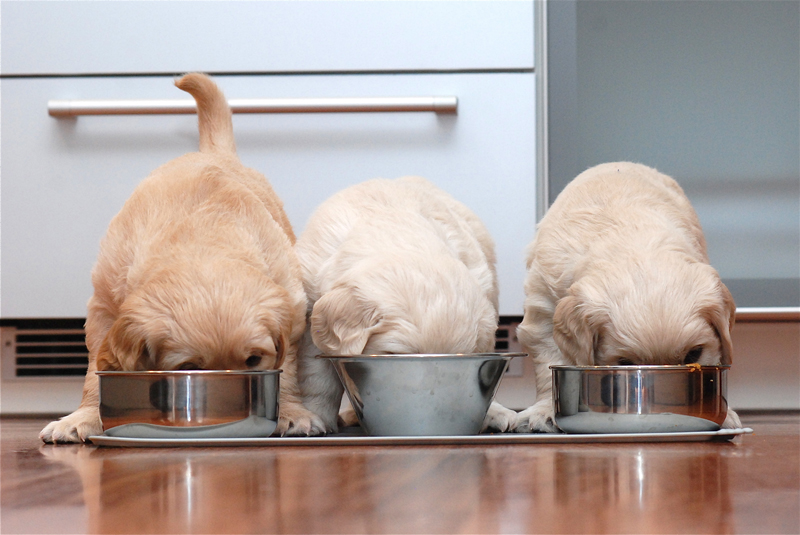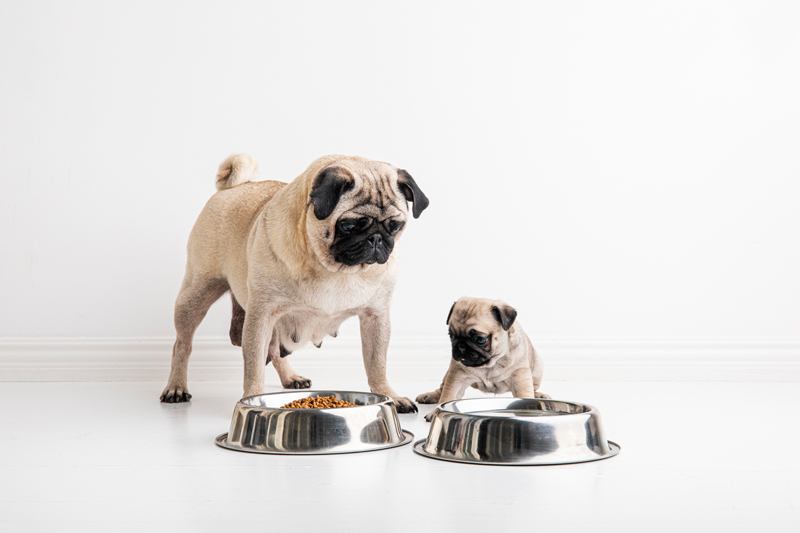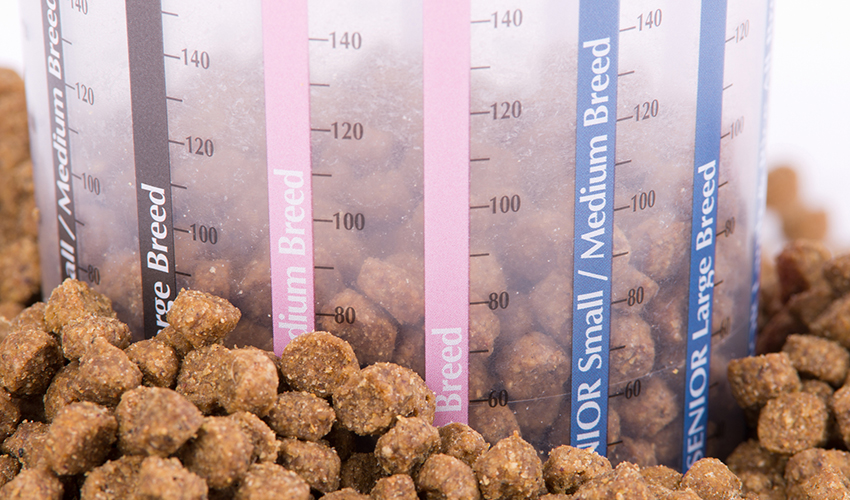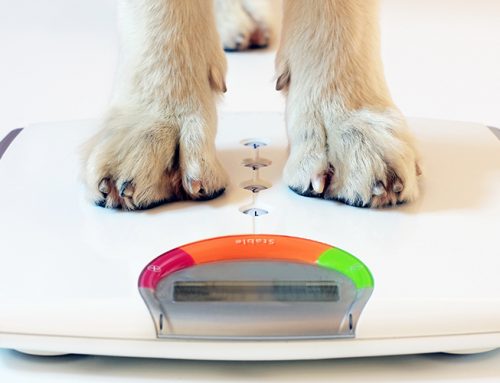Dog owners typically get their new puppy when it’s about eight to 12 weeks old and already weaned. One of the most pressing and immediate concerns with this new family member is how much to feed it. This can be especially stressful for first-time dog owners. The first trip to the dog food aisle or your favorite online retailer can be overwhelming. There’s so much choice! You need to choose a food — or foods — then figure out how much your wriggly puppy needs to eat.
Puppies need a lot of calories to support their growth. Puppy food tends to be more calorie-dense than adult food. But at the same time, you don’t want your puppy to grow as fast as possible. These two things may sound like they’re contradictory, so let’s look at the difference between maximum growth and optimal growth.
Veterinarians recommend that you ensure your puppy grows at an optimal rate. This doesn’t mean as quickly as possible — it means slow and steady is the best approach. In particular, large breed puppies are at high risk for health issues if they grow too fast. If your puppy has come from a specialized breeder, the breeder will have advice on the best growth rate for your dog.
“Pups grow up, but it is important that they grow at the proper rate,” writes veterinarian Lynn Buzhardt for VCA Hospitals. “The framework of the body is composed of muscle and bone which have to grow in synchrony. Rapid growth rates can stress developing bones and joints resulting in skeletal malformations.”
She notes that some skeletal problems are genetic and not within a dog owner’s control, but that diet can also have a big impact on development. Diet is something dog owners can control.
Puppies need a well-rounded diet of protein, carbs, minerals, vitamins and fat. The safest bet is to choose a food that is specifically for puppies. If you have a small breed or large breed pup, there are also food options targeted specifically at these two groups. Large breed puppies need a diet that is lower in calcium and fat than an average dog. Small breed pups can benefit from smaller kibble sizes sometimes found in small breed-specific dog food. Small breed puppy food is sometimes formulated to offer more calories per bite than regular puppy food because small breed pups are at a higher risk of hypoglycemia.
Another option is to find food labeled for “all stages of life”. In both puppy food and in food that is suggested for all ages, there are two specific things to look at in the ingredients list: protein content and fat content.
The American Association of Feed Control Officials sets the guidelines for the nutrient profile of puppy food. Puppies need a minimum of 22 percent protein and 8 percent fat. These are minimums — most quality dog foods will offer higher levels of both fat and protein, which are necessary for healthy bone, skin, teeth, and coat growth, not to mention brain development. Fat is more calorie-dense than protein, which is why food formulated for large breed puppies may contain less fat than regular puppy food.

So how much puppy food does my pup need?
Food servings depend on many factors: activity level, age, and breed among them. You may not get the serving size correct right out of the gate. You might need to experiment! Or get advice from a friend, or from your vet, or breeder.
As a starting place, you can look at the recommended serving size on your package. It will have a suggested calorie intake and serving size. The serving size is for the whole day, so you’ll need to break it into smaller portions for meals throughout the day. Puppies typically need to eat about three or four times a day because they have small stomachs and can only eat so much in one go.
Puppies aren’t good with portion control, so you should take care of this for your new dog and only have food available at mealtimes, rather than free-feeding. Free feeding may result in your puppy eating too much.
Treats should only make up about five percent of total daily calories. If you’re using treats for training your puppy, mix up commercially produced treats with little pieces of vegetables, which are lower in calories.
How do I know for sure my puppy is getting enough food? Or if it’s getting too much?
Veterinarians have something called a body conditioning score they use to assess if a dog is overweight, underweight, or just right. The good news is, you can use it too! Once you learn how to assess your dog’s overall weight, you can adjust their food serving size as their body shape changes.
The body conditioning score is a nine point standardized scale that is based on how your dog looks. A score of one means your dog is too thin, and a score of nine is obese. A healthy weight is around four or five, depending on the breed. A dog with a score of one will have visible ribs, vertebrae, and pelvic bones. Its waist, when viewed from above, will have a sharp and drastic abdominal tuck behind the rib cage, and the dog will have little to no visible muscle mass.
A healthy weight dog will not have visible ribs, although you will be able to feel them. The abdominal tuck is clear, and dogs will have a visible waist from above but no obvious bony protrusions on its back. The dog will look fit and well-muscled, and its rib cage will slope moderately up to its back legs when viewed from the side. You may have to adjust your puppy’s serving size several times to keep the dog at its optimal weight.
Your puppy’s body conditioning score may fluctuate as it goes through growth spurts. After about 10 weeks old, puppies should have lost their roly-poly look and start to lean out.
Adjust your dog’s serving size to keep it in a healthy weight range.
When can my puppy eat adult food?
Consult with your vet or dog breeder for advice about changing over to adult dog food, which can generally be done when your puppy reaches 80 percent of its full-grown size. You’ll likely need to adjust your dog’s serving size again because adult dog food is formulated differently than puppy food.

Puppies hit the 80 percent milestone at a range of ages. Smaller breeds get there first. A dog that is less than 20 pounds at full size may hit their adult size by seven or nine months old. Toy Poodles, Miniature Pinschers, and Pekinese, for example, are among the dogs that reach physical and sexual maturity quickest.
A giant breed dog may not hit the 80 percent milestone until they are around 18 months, or even older. Some giant breed dogs — dogs that are 150 pounds or so — may not reach full maturity until about three years old. Large and giant breed puppies are the most likely to develop hip dysplasia and developmental orthopedic diseases if they grow too quickly, and should never be fed adult food while they’re still growing because of the calcium content in adult food.
Most dogs will fall somewhere in the middle and will reach full maturity between one or two years old. They’ll stop getting taller — although they may continue to put on muscle weight.
The American Kennel Club (AKC) says that puppies are ‘officially’ considered adult dogs once they’re a year old but acknowledge that dogs may continue to grow beyond the one year mark.
Keeping a puppy on puppy formulated food for too long can lead to obesity because of the higher fat content in puppy food. It is important to change to an adult formulation at the right time so your puppy isn’t at risk of obesity and obesity-related illnesses.






